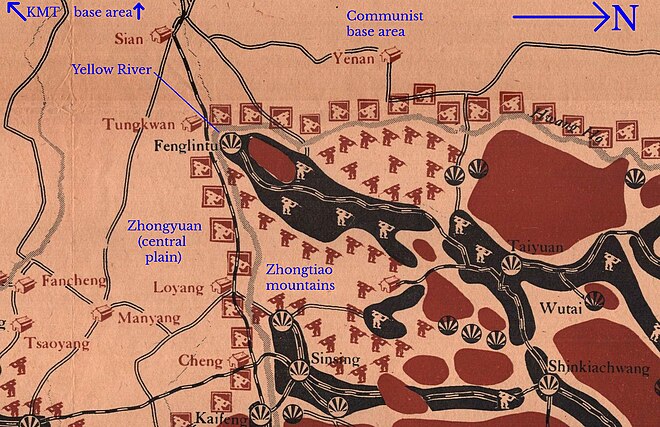Battle of South Shanxi
| Battle of South Shanxi | |||||||
|---|---|---|---|---|---|---|---|
| Part of the Second Sino-Japanese War | |||||||
 A map of the battle | |||||||
| |||||||
| Belligerents | |||||||
|
|
| ||||||
| Commanders and leaders | |||||||
|
|
| ||||||
| Strength | |||||||
| 180,000 troops in 8 armies | 100,000 troops in 6 divisions, 3 brigades | ||||||
| Casualties and losses | |||||||
|
25,066 killed or wounded and 21,611 missing [2] 75,600 killed, wounded, or missing [3] | More than 20,000 troops | ||||||
The Battle of South Shanxi , also known as the Battle of Jinnan (Chinese: 晉南战役) and Zhongtiao Mountains campaign (Chinese: 中條山會戰) by the Chinese and as the Chungyuan Operation by the Japanese, was one of the 22 major engagements between the National Revolutionary Army and the Imperial Japanese Army during the Second Sino-Japanese War (1937–1945).
Context
[edit]
The disastrous losses of the first year of the war (1937-38) meant that the internationally-recognized Chinese government (controlled by the Kuomintang or KMT party) had been forced to abandon its capital and all the industrialized areas of the country. It fought on from a new base in the west, mainly the province of Sichuan and Guanzhong.
The Zhongtiao Mountains held symbolic importance as the largest area of territory north of the Yellow River still under full Chinese control.
They also had some strategic importance as defensive ground on the north bank of the Yellow River. Beyond the south bank lay the railway line connecting the KMT's western base with the Zhongyuan central plain, the 'breadbasket of China'.[4]
The area of the battle was very roughly in the shape of a triangle, with the Yellow River as the base to the south. On the northwest side were Japanese armies that had advanced down the railway line from the north as far as its Yellow River terminus at Fenglingdu. Likewise, the frontline to the northeast side was the territory captured by the Beiping–Hankou Railway Operation.
At the onset of the battle, KMT-CPC relations were at a low point following the still recent New Fourth Army incident in early 1941. As a result, the nearby 8th Route Army refused to assist the surrounded Nationalists. South Shanxi was later remembered in China as one of the worst defeats of the entire war.
Campaign
[edit]The campaign is extensively discussed in the travel book Two Kinds of Time by the US journalist Graham Peck, based on eyewitness interviews with refugees. Peck reports that the NRA had built a line of fortifications overlooking the major roads through the mountains, which had withstood several earlier Japanese assaults. It was garrisoned by second-line warlord troops. He claims that the Chinese commanders had become complacement and were caught out when the Japanese adopted new, guerrilla-style tactics. They used peasant paths to infiltrate into the mountains and encircled the mountain range by moving along north bank of the Yellow River. Once they realized they were surrounded, the Chinese forces disintegrated before better-quality troops could be brought across the river.[5]
Order of battle
[edit]Source:[6]
Chinese
[edit]1st War Area – Wei Lihuang
- 5th Army Group – Zeng Wanzhong
- 3rd Corps – Tang Huaiyuan
- 7th Division
- 12th Division
- 80th Corps – Kong Lingxun
- 165th Division
- New 27th Division
- 34th Division – Kung Pingfan
- 3rd Corps – Tang Huaiyuan
- 14th Army Group – Liu Mao'en
- 15th Corps – Wu Tinglin
- 64th Division
- 65th Division
- 98th Corps – Wu Shiming
- 42nd Division
- 169th Division
- 15th Corps – Wu Tinglin
- 9th Corps – Pei Changhui
- 47th Division
- 54th Division
- New 24th Division
- 17th Corps – Gao Guizi
- 84th Division
- New 2nd Division
- 43rd Corps§ – Zhao Shiling
- 70th Division
- New 47th Division
- 14th Corps – Chen Tie
- 85th Division
- 94th Division
- 93rd Corps – Liu Kan
- 10th Division
§ 43rd Corps was formerly with 2nd War Area.
Japanese
[edit]North China Front Army – Major General Hayao Tada (Early May 1941)
- 35th Division – Lt. Gen. Kumakichi Harada
- 21st Division – Lt. Gen. Hisakazu Tanaka
- 33rd Division – Lt. Gen. Shozo Sakurai
- 4th Cavalry Brigade (partial) – ?
- 1st Army – Lt. Gen. Yoshio Shinozuka
- 36th Division – Iseki Mitsuru
- 37th Division – Adachi Hatazo
- 41st Division – Shimizu Noritsune
- 9th Independent Mixed Brigade – Major General Kenkichi Ikenoue
- 16th Independent Mixed Brigade – Major General Heiji Wakamatsu
References
[edit]- ^ Peck, Two Kinds of Time, p.287
- ^ 國史館檔案史料文物查詢系統,衛立煌電蔣中正中條山戰役各部隊官兵馬騾傷亡失蹤與機槍等武器損毀數量情形且因數量過大無法按編制一次補足情形,典藏號:002-090200-00070-304 [1]
- ^ Liu, Fenghan (2008). 中國近代軍事史叢書: 抗戰 (上, 下). p. 419.
- ^ "Big Japanese drive in Shansi". Hong Kong Daily Press. 13 May 1941. p. 4. Retrieved 31 December 2023.
- ^ Peck, Graham (1950). Two Kinds of Time (Paperback ed.). Seattle & London: University of Washington Press (published 2008). pp. 238–284. ISBN 9780295988528.
- ^ Hsu, Long-hsuen; Chang, Ming-kai (1971). History of The Sino-Japanese War (1937-1945). Translated by Wen, Ha-hsiung (2nd ed.). Taipei: Chung Wu Publishing.
